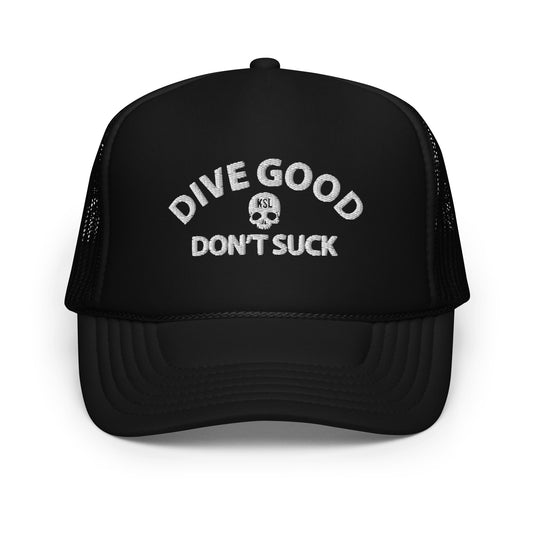Safety in Spearfishing - Never Dive Alone!
Share
Spearfishing is one of the most challenging and rewarding forms of fishing. It combines physical fitness, patience, and skill with a deep respect for the ocean and its inhabitants. However, it also involves significant risks, especially when diving to depths with little more than a speargun, mask, and fins. One of the most important safety rules for spearfishers is never to go out alone. Spearfishing with a buddy not only enhances safety but also increases the likelihood of bringing home a good catch. This concept extends to freediving, where the "one up, one down" rule is widely recognized as a crucial practice for ensuring safety.

The Safety Perspective
1. Mitigating the Risks of Shallow Water Blackout
One of the most significant risks in spearfishing is shallow water blackout (SWB), a condition in which a diver loses consciousness due to a lack of oxygen as they ascend from depth. SWB is unpredictable and can happen to even the most experienced divers. A spearfisher who experiences this while alone is at a grave risk of drowning. However, when diving with a buddy, this risk can be mitigated.
The "one up, one down" rule is particularly effective in preventing fatalities related to SWB. This rule dictates that one diver remains at the surface while the other is submerged. The diver at the surface acts as a spotter, ready to assist if their buddy shows signs of distress or fails to resurface on time. By following this system, the diver underwater knows that help is immediately available if they need it. A buddy can quickly dive down to rescue an unconscious spearfisher and bring them back to the surface for emergency care.
2. Providing Immediate Assistance in Case of Equipment Failure
Spearfishing gear is generally simple, but failures can still occur. For example, a speargun may misfire, a weight belt may get stuck, or a mask may suddenly leak. In these situations, having a buddy nearby can be crucial. A partner can assist with resolving equipment malfunctions, providing an extra set of hands or tools to fix the problem. If the issue can't be solved underwater, the buddy can help the diver return to the surface safely.
Additionally, a spearfishing buddy can carry spare equipment, such as an extra knife, in case of an emergency. Cutting a diver free from a tangled line or fishing net can mean the difference between life and death in some circumstances.
3. Responding to Marine Life Encounters
While most marine life poses little threat to spearfishers, some encounters can be dangerous. Sharks, barracudas, and other large predators may be attracted by a struggling fish or the scent of blood in the water. Although rare, aggressive interactions with such creatures can be life-threatening. Diving with a buddy adds a layer of protection in these scenarios. A second person can help fend off an inquisitive shark, scare away dangerous animals, or assist if someone is injured.
Beyond predators, certain marine environments present additional hazards, such as strong currents, sharp coral, or jellyfish stings. A buddy can help navigate these challenges and provide assistance if one diver is injured or exhausted.
4. Monitoring Fatigue and Hydration
Spearfishing is physically demanding, especially when done in warm climates, where dehydration and fatigue can set in more quickly. Diving deep and holding your breath while exerting effort to stalk and spear fish requires high levels of fitness and concentration. Over time, divers may become mentally or physically fatigued, which can impair judgment and reaction times. A buddy can monitor each other’s energy levels and suggest breaks when necessary, reducing the risk of accidents caused by overexertion.
Increasing the Chances of Bringing Home Fish
In addition to the vital safety benefits, spearfishing with a buddy can improve your overall hunting success. By working together, you can increase your chances of landing a catch, cover more ground, and enjoy a more efficient and rewarding experience.
1. Tag-Teaming on Fish
Some species of fish are highly elusive, and even the best spearfishers can struggle to land a shot. When hunting with a buddy, the two of you can work together to stalk and corner the fish. One diver can draw the fish's attention, allowing the other to take a shot from a different angle. This technique works particularly well when targeting larger, more wary fish, such as groupers or pelagic species like tuna or amberjack.
If one diver shoots a fish but doesn’t land a perfect shot, their buddy can assist by delivering a second shot to secure the catch. This teamwork approach not only improves the success rate but also helps to ensure that the fish is killed humanely and doesn't escape to die later from injuries.
2. Covering More Territory
Spearfishing involves a lot of searching—finding the right spots, identifying fish, and setting up the perfect ambush. When diving alone, this process can be slow and methodical. However, with a buddy, the workload can be shared, and you can cover more ground. One diver can explore one side of a reef or rock structure while the other checks the opposite side. By splitting up but staying within visual range, you can search a larger area in less time, increasing the likelihood of finding fish.
Once a good hunting spot is identified, buddies can take turns diving to avoid spooking the fish. This alternating approach allows each person to hunt while ensuring that one diver is always rested and ready for the next drop.
3. Sharing Knowledge and Techniques
Every spearfisher has their own methods and strategies for stalking, aiming, and shooting fish. When spearfishing with a buddy, you have the opportunity to learn from each other. You might discover new techniques for getting closer to fish, better ways to conserve energy during dives, or tips for improving your accuracy with the speargun. Sharing this knowledge not only improves individual skills but also fosters a collaborative environment where both divers can succeed.
4. Better Fish Retrieval
Landing a fish is only half the battle; retrieving it can be just as challenging, especially if you're hunting in deep water or near complex structures like reefs or wrecks. A fish that has been speared may dive into a crevice or swim deeper in an attempt to escape. With a buddy, retrieval becomes easier. One person can dive down to secure the fish, while the other waits at the surface to assist if needed. This cooperation ensures that more fish are successfully brought to the surface and reduces the risk of losing a catch.
Conclusion
Spearfishing with a buddy is not just a good idea—it’s essential. From a safety perspective, having someone there to watch your back, assist in emergencies, and provide support when needed can mean the difference between life and death. The "one up, one down" rule is a proven method for preventing shallow water blackouts, one of the most dangerous risks in freediving and spearfishing.
Beyond safety, spearfishing with a buddy increases the odds of success. By working together, divers can cover more ground, tag-team fish, and share valuable insights and techniques. Whether you're a seasoned spearfisherman or new to the sport, having a buddy alongside you not only enhances the experience but also ensures that you make it back to shore safely with a full stringer of fish.
Looking for gear? We've compiled some lists that could help here.












